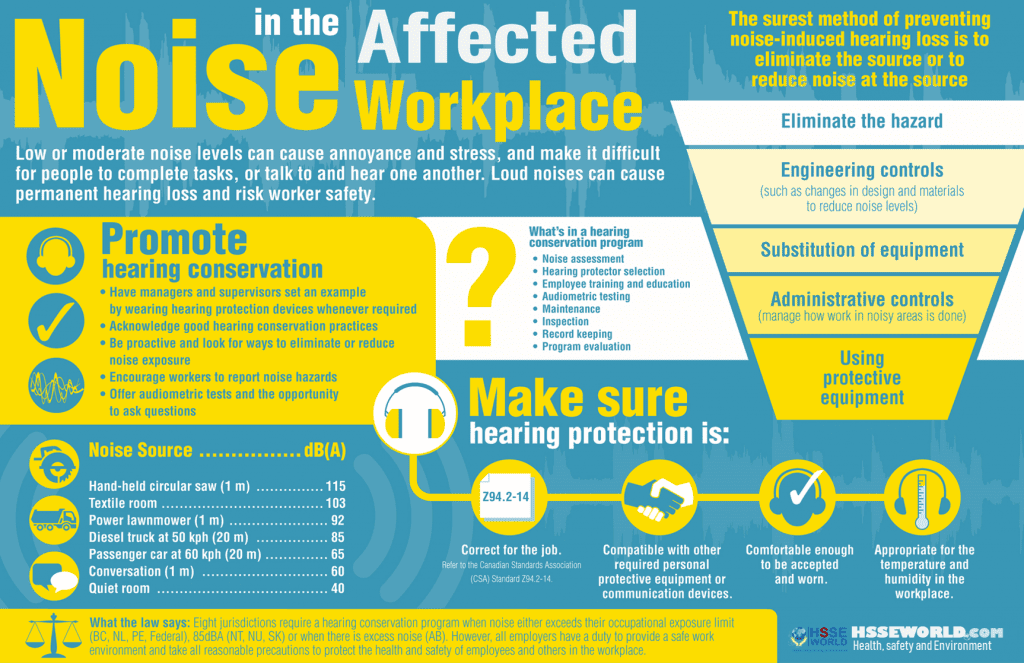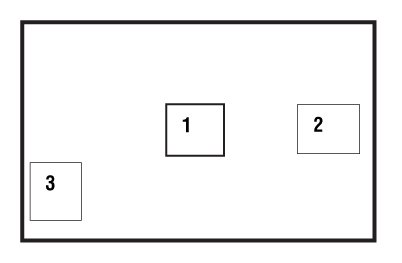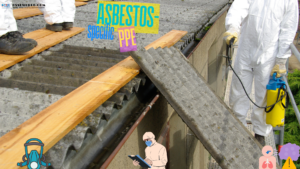Photo of the day: Noise in the affected workplace
11 min readOne of the most common health hazards in the workplace, noise can have serious impacts on our health, safety, and well-being. Noise can be annoying and disruptive, risk our safety if signals, speech, and machinery can’t be heard, and even permanently damage our hearing.
The photo of today and infographic outlines what the law says and ways in which workplaces can be proactive about preventing hearing loss and Noise control Measures.


First, let’s know How is the noise made
Sound can be produced by vibration or as a result of aerodynamic systems.
Vibration-induced noises are produced by:
- Mechanical shocks and friction between parts (e.g., hammering, pressing, running gears, bearings, cutting tools, chutes, hoppers, etc.)
- Out of balance moving parts (e.g., unbalanced rigid rotors)
- The vibration of large structures (e.g., ventilation ducts, guards on machines, equipment supporting structures, etc.)
The sound may be amplified by reflective surfaces that are around the devices.
Aerodynamic sources of noise are air or fluid flows through pipes and fans, or as the pressure drops in the air distribution system. Examples include:
- Steam released through exhaust valves
- Aircraft jets
- The turbulent flow of water through pipes
- Fans
- Combustion motors
What are the steps to take to control the noise in the workplace?
The steps that must be taken in order to effectively and efficiently control the noise in the workplace are:
- Identify the sound sources: vibrating sources and aerodynamic flow.
- Identify the path of the noise from the source to the worker.
- Determine the sound level of each source.
- Determine the relative contribution to the excessive noise of each source and rank the source accordingly. To obtain significant noise attenuation, the dominant source should be controlled first.
- Know the acceptable exposure limits identified in the health and safety legislation and quantify the necessary sound reduction.
- Identify solutions by taking into consideration the degree of sound attenuation, operation, and productivity restraints, and cost.
How can we reduce noise exposure?
The exposure to noise can be reduced by eliminating the source of noise (if possible), substituting the source with a quieter one, applying engineering modifications, using administrative controls, and using protective equipment.
The best way to reduce exposure to noise is to engineer it out at the design stage. In terms of equipment, always try to choose features that will reduce the noise level to a minimum acceptable level. In terms of new installations, select quiet equipment, have a procurement policy that opts for acquiring quiet equipment, and eliminate design flaws that would amplify the noise.
Engineering modifications, those changes that affect the source or the path of the sound, are the preferred methods of noise control in already established workplaces where noise protection was not factored in at the design stage. It is generally agreed that the solutions controlling the source are more cost-effective than those controlling noise along the path. See the engineering solutions below for examples.
Administrative controls, (such as reducing the length of time the worker is required to work in a noisy area), and the use of personal protective equipment (PPE) are measures that control the noise at the worker. Depending on the type and level of noise; the number of workers exposed, and the type of work, engineering controls might not always be considered as reasonable solutions. Where the exposure would not justify the implementation of more expensive solutions, a combination of administrative control (limitation of exposure length) and personal protective equipment may be considered. However, we must keep in mind that the administrative measures and the use of PPE may not be effective in protecting the workers (e.g., PPE may be used incorrectly or may not be used at all; administrative controls may not be followed, etc.). The use of PPE should be the last resort for controlling the exposure to noise.
( Read more:occupational-noise-hearing-conservation-basics/)
What engineering solutions can be used to reduce vibration-induced noise?
Some of the engineering solutions recommended for reducing vibration at the source are:
- Modification of the energy source such as reducing the speed of the fan, reducing the force of impact, etc.
- Damping or covering surfaces that vibrate due to mechanical forces (e.g., chutes and hoppers) with viscoelastic materials such as bitumastic, plastic, silicone, hard rubber, and other elastomeric polymers. Single-layer damping occurs when the surface is covered with a layer of material that is one to three times thicker than the surface itself. This solution is suitable for thin structures.
To prevent damage due to friction and impact with other materials, the damping material may be sandwiched between the wall of the equipment and a steel sheet or another material resistant to abrasion. This treatment is known as constraint layer treatment and is adequate for chutes, hoppers, machine guards, conveyors, etc. Certain rules regarding the thickness of the damping material in relation to the thickness of the structure to be coated must be observed in order to obtain adequate noise reduction.
- Minimizing gaps in machine guards and/or covering them with acoustic absorbent material.
- Replacing chain and gear drives with belt drives.
- Replacing metal gears with plastic gears.
- Using gears with tooth patterns that provide a quiet run (e.g., chevron and other helical patterns).
- Replacing metal parts with plastic ones.
- Replacing motors with quieter ones.
What engineering solutions can be used to reduce aerodynamic-induced noise?
Noise control specialists recommend the implementation of the following engineering practices to reduce the noise associated with unstable air or water flow.
- Minimize fluid velocity and increase the diameter of pipes.
- Minimize turbulence by using large, low-speed fans with curved blades. The following table illustrates the correlation between the reduction of the speed of the fan and the noise attenuation.
| Speed Reduction | Noise Reduction dB |
|---|---|
| 10% | 2 |
| 20% | 5 |
| 30% | 8 |
| 40% | 11 |
| 50% | 15 |
(From Health and Safety Executive (no date) – Best Practice in Noise Control)
- Avoid elbows when installing a centrifugal fan.
- Increase distance between fans and devices that may reduce efficiency and increase noise (bends, dampers)


- Choose quiet entraining nozzles (nozzles designed to draw and transport the air quietly) instead of simple nozzles
What are other engineering controls?
Enclosure and isolation
Noisy equipment can be enclosed in spaces or rooms that have special acoustic features – such as sound-isolating, acoustic louvers, or sealed windows and doors. The degree of sound attenuation will depend on the noise reduction properties of the materials used to build the room.
In many cases, only the individual machine is enclosed. The enclosure can be total or partial. Partial enclosures are preferred where worker access for operating or maintenance is required. The noise attenuation offered by the partial enclosures is however lower than that of a total enclosure. An alternative to the enclosure of the equipment is the enclosure of the workers. The workers may operate remotely the equipment from an isolated room.
Isolation is used to reduce the sound transmitted through vibrations. The equipment is isolated from radiating surfaces by materials such as springs, elastomeric materials, cork, and foam rubber. For example, heavy vibrating machinery can be supported by isolating springs and rubber inserts, or vibrating pipes can be supported by brackets that are padded by rubber isolators or by springs.
Acoustic barriers
Acoustic barriers are panels made of sound-absorbing material which are placed between the source of noise and the worker. Panels must be designed appropriately (e.g., panels placed in highly reflective rooms are not always effective in attenuating the noise that reaches the worker).
Installation of silencers in the ducts and at pneumatic exhausts
Silencers are devices that allow the fluid to pass but restrict the passing of the sound by reflecting or dissipating the sound. Sound dissipation occurs in silencers containing absorbing materials. In reflective silencers, the sound propagation is reduced due to the existence of expansion chambers (as in the car mufflers) or openings.
(Read more:OSHA-limits-on-workplace-noise-feed-complaints/
What other general measures can I take to control the noise?
Perform regular maintenance. Focus on identifying and replacing worn or loose parts, lubricating moving parts, and ensuring that rotating equipment does not go off balance.
Substitute noisy processes with quieter ones. For example, replace:
- Pneumatic ejectors with mechanical ones
- Rolling or forging with pressing
- Impact riveting with welding
- Circular saw blades with damped blades
Reduce sound reverberation in the room. Reverberation happens when the sound produced in an enclosure hits a hard reflective surface. The sound reflects back in the room and ads to the original source. The strength of the reverberation decreases with the distance from the source to the reverberating surface. In some cases, the reverberated sound may dominate the original sound. In such cases, padding the reflective surfaces with sound-absorbing materials will reduce the sound level.


Reverberation can be reduced by arranging the equipment in the room in such a way that the equipment is not too close to too many reflective structures. The sound level of a noise source placed near hard reflective surfaces increases by 3 dB for each surface. For example, if a motor is placed directly on the floor, close to one of the walls of the room (the motor is close to two surfaces) (Figure 3, Position 2), the sound level will increase by 6 dB; if the same motor is placed in the corner of the room (close to three surfaces: two walls and the floor) (Figure 6, Position 3), the sound level will increase by 9 dB.


Another way to reduce the sound radiation is to reduce the radiating surface (e.g. covering a transmission gear with a mesh enclosure instead of a solid box).Document last updated on January 17, 2017
Add a badge to your website or intranet so your workers can quickly find answers to their health and safety questions.
Promote hearing conservation
- Have managers and supervisors set an example by wearing hearing protection devices whenever required
- Acknowledge good hearing conservation practices
- Be proactive and look for ways to eliminate or reduce noise exposure
- Encourage workers to report noise hazards
- Offer audiometric tests and the opportunity to ask questions
What’s in a hearing conservation program?
- Noise assessment
- Hearing protector selection
- Employee training and education
- Audiometric testing
- Maintenance
- Inspection
- Record keeping
- Program evaluation
The surest method of preventing noise-induced hearing loss is to eliminate or reduce noise at the source.
- Eliminate the hazard
- Engineering controls (such as changes in design and materials to reduce noise levels)
- Substitution of equipment
- Administrative controls (manage how to work in noisy areas is done)
- Using protective equipment
| Noise Source | dB(A) |
|---|---|
| Hand-held circular saw (1 m) | 115 |
| Textile room | 103 |
| Power lawnmower (1 m) | 92 |
| Diesel truck at 50 kph (20 m) | 85 |
| Passenger car at 60 kph (20 m) | 65 |
| Conversation (1 m) | 60 |
| Quiet room | 40 |
Make sure hearing protection is:
- Correct for the job. Refer to the Canadian Standards Association (CSA) Standard Z94.2-14.
- Compatible with other required personal protective equipment or communication devices.
- Comfortable enough to be accepted and worn.
- Appropriate for the temperature and humidity in the workplace.
What the law says
Eight jurisdictions require a hearing conservation program when noise either exceeds their occupational exposure limit (BC, NL, PE, Federal), 85dBA (NT, NU, SK), or when there is excess noise (AB). However, all employers have a duty to provide a safe work environment and take all reasonable precautions to protect the health and safety of employees and others in the workplace.
Download Infographic
Noise in the affected workplace
More Photos
- Photo of the day: 10 Essential Safety Tips for Driving in Hot Weather Conditions
- Photo of the day: best workplace safety tips
- Photo of the day: The Importance of Stop Work Authority in Maintaining Workplace Safety
- Photo of the day: Tomorrow’s Reward for Working Safely Today: Cultivating a Culture of Safety
- Photo of the day: Preventing slips and trips at work
- Photo of the day: Learn the DRSABCD action Plan
- Working with Electricity Electrical Accidents Guide for Electrical Workers
- Photo of the day: Hearing Protection Device Selection
- Photo of the day: If An Earthquake Shakes You-Infographic free
- Fire Safety Posters Free Download
- Photo of the day: First Aid for Electrical Burns-Infographic free
- Infographic: First Aid for Cuts and Scrapes free download
- Photo of The day: Work Safe with Lasers-Laser Safety free
- Photo of the day: Working Safely with chemicals and chemical Management
- Photo of the day: Safe work practices when using MEWPs ( updated)
- Photo of the day: Preventing Common Kitchen Hazards
- Photo of the day: Safe handling of Gas Cylinders and lecture bottles
- Photo of the day: Forklift Stability Triangle
- Photo of the day: Defective Tools Safe Work Practice
- Photo of the day: Lift With Your Legs Not With Your Back
- Photo of the day: First Aid for burns
- Photo of the day: The 7 Principles of HACCP
- Photo of the day: Working Safely with Suspended Loads
- Photo of the day: Heat Stroke First Aid and safety posters
- Photo of the day: Near-Miss Reporting and Posters
- Photo of the day: Ergonomic chair and office chair safety tips
- Photo of the day: Whole Body Vibration
- Photo of the day: Substation Safety Equipment
- Photo of the day: Bypassing Safety Controls Rules
- Photo of the day: Lightning Safety Tips
- Photo of the day: Overhead Power lines Clearance
- Photo of the day: Floor Marking
- Photo of the day: Types of Foot Protection
- Photo of the day: Types of Hand Protection
- Photo of the day: Lockout and Tagout Safety
- Photo of the day: Fall Protection Plans
- Photo of the day: Flood Safety Tips
- Photo of the day: Read All Labels Work safe
- Photo of the day: Run Project safely with Crane Hand Signals
- Photo of the day: Flagman and Traffic control
- Photo of the day: Managing Risks of Exposure to Solvents in the workplace
- Photo of the day: Scissor Lift Safety
- Photo of the day: HSE Bulletin Board
- Photo of the day: Arc-Fault Circuit Interrupters (AFCI)
- Photo of the day: Safe use of ladders and step ladders
- Photo of the day: Concrete Truck Driver Hand Signals
- Photo of the day: Extension Cord Safety Tips
- Photo of the day: Protect your Head
- Photo of the day: choosing the right Anchorage
- Photo of the day: Work-Related Asthma
- Photo of the day: Top FIVE Heavy Equipment Construction Site Safety Tips
- Photo of the day: sun safety in the workplace
- Photo of the day: Cannabis and Impairment in the Workplace
- Photo of the day: Position for safety and comfort-Safety Tips
- Photo of the day: Generator Safety
- Photo of the day: Controlling COVID-19 in the Workplace-Physical Barriers
- Photo of the day: Manual Material handling
- Photo of the day: Personal Protective Equipment last resort
- Photo of the day: WHMIS 2015 – Pictograms
- Photo of the day: Indoor Air Quality
- Photo of the day: Noise in the affected workplace
- Photo of the day: Fatigue at Work
- Photo of the day: Don’t be Driven to Distraction
- Photo of the day: working in heat and Humidex Rating
- How to use Plate Clamps Safely: Safety Moment#34
- Photo of the day: Sitting at work
- Photo of the day: 5 ways to reduce the risk of Slipping and Tripping
- Photo of the day: Preventing the spread of contagious illness
- Photo of the day: Incident Investigations
- Photo of the day: 10 Scaffold Safety Essentials
- Photo of the day: Effective Health and Safety Committees
- Photo of the day: New worker Orientation & Safety Orientation checklist
- Photo of the day: Workplace Inspection
- Photo of the day: musculoskeletal disorders
- Photo of the day: Emergency preparedness in the workplace
- Photo of the day: Mental health in the workplace
- Photo of the day: Trenching Safety Tips That Can Save a Life
- Photo of the day: Dangerous Goods Classes
- Photo of the day: Safety Equipment for Confined Spaces
- Photo of the day: Tips to reduce Heat stress in the workplace
- Photo of the day: hierarchy of controls
- Your steps to chemical safety
- H2S Gas and how to handle its Emergency
- Photo of the day: Importance of Mock drill and Fire Action Emergency Procedure
- Photo of the day: Choosing the Right Face Mask and the difference between a respirator and face mask
- Photo of the day: Confined space safety Precautions
- Breath Safely: The Proper Use of Respiratory Protection
- Photo of the day: Electric shock survival
- Photo of the day: Chemical Spill Emergency Response
- Photo of the day: Construction Site fire Safety
- Photo of the day: Confined Space rescue




1 thought on “Photo of the day: Noise in the affected workplace”